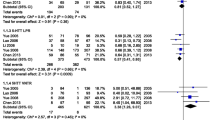Abstract
Background
Obesity represents a major risk factor for Obstructive Sleep Apnea Syndrome (OSAS). Brain-derived neurotrophic factor (BDNF) affects the mechanisms that regulate weight, eating behavior, and metabolism. This project aims to investigate the possible association of BDNF gene polymorphism with obesity and OSAS, and to contribute knowledge to the understanding of the pathophysiology of OSAS.
Methods
The subjects included in this study were selected among the individuals who were hospitalized in the Erciyes University Medical School Chest Diseases Sleep Medicine Laboratory. Subjects were divided into four groups based on the presence of OSAS and/or obesity. Group 1 included OSAS+ obesity+ patients, Group 2 included OSAS+ obesity− patients, Group 3 included OSAS− obesity+ patients, and Group 4 included OSAS− obesity− patients. The targeted patient number per each study group was 45, but only 32 patients could be enrolled into Group 3.
Results
Out of a total number of 167 subjects, 117 (70.1 %) had BDNF 196G/G, 48 (28.7 %) had BDNF 196G/A, and 2 (1.2 %) had BDNF 196A/A genotype. Of 48 subjects having BDNF 196G/A genotype, 32 (66.6 %) were obese, and 16 (33.3 %) were non-obese. Out of 90 subjects with OSAS, 64 (71.1 %) had BDNF 196G/G, and 25 (27.8 %) had BDNF 196G/A genotype. Out of 77 subjects without OSAS, BDNF 196G/G, and BDNF 196G/A genotypes were detected in 53 (68.8 %) and 23 (29.9 %) subjects, respectively. A statistically significant difference was demonstrated between the four study groups in terms of BDNF rs6265 polymorphism (p = 0.013). This difference was attributed to OSAS+ obesity− Group, in which BDNF 196G/G genotype was more common and BDNF 196G/A polymorphism was less common than the patients in other groups.
Conclusion
In conclusion, BDNF 196G/A genotype was found to be more frequent among obese patients compared to the non-obese individuals, but it was not significantly related to OSAS in the present study. BDNF196G/G genotype was more common and BDNF 196G/A polymorphism was less common among OSAS+ obesity- subjects compared to the other study groups.
Similar content being viewed by others
References
Schwab RJ, Pack AL (1998) Fishman’s pulmonary diseases and disorders. Mc Graw-Hill Book Company, New York, pp 1617–1637
Young T, Palta M, Dempsey J, Skatrud J, Weber S, Badr S (1993) The occurrence of sleep-disordered breathing among middle-aged adults. N Engl J Med 328:1230–1235
Mortimore IL, Marshall I, Wraith PK et al (1998) Neck and total body fat deposition in nonobese and obese patients with sleep apnea compared with that in control subjects. Am J Respir Crit Care Med 157:280–283
Schwartz AR, Patil SP, Laffan AM et al (2008) Obesity and obstructive sleep apnea: pathogenic mechanisms and therapeutic approaches. Proc Am Thorac Soc 5:185–192
Lindsay R, Wiegand S, Altar C et al (1994) Neurotrophic factors: from molecule to man. Trends Neurosci 17:182–190
Lommatzsch M, Zingler D, Schuhbaeck K et al (2005) The impact of age, weight and gender on BDNF levels in human platelets and plasma. Neurobiol Aging 26:115–123
Pelleymounter MA, Cullen MJ, Wellman CL (1995) Characteristics of BDNF-induced weight loss. Exp Neurol 131:229–238
Thorleifsson G, Walters GB, Gudbjartsson DF et al (2009) Genomewide association yields new sequence variants at seven loci that associate with measures of obesity. Nat Genet 41:18–24
Staats R, Stoll P, Zingler D et al (2005) Regulation of brain-derived neurotrophic factor (BDNF) during sleep apnoea treatment. Thorax 60:688–692
Wang Y, Wang JJ, Zhao MQ et al (2010) Regulation of BDNF in obstructive sleep apnoea. J Int Med Res 38:1942–1951
World Health Organization Expert Committee: Physical Status: The Use and Interpretation of Anthropometry. WHO Technical Report Series No: 854. Geneva, World Health Organization 1995
Rechtschaffen AK (1968) A manual of standardized terminology, techniques and scoring system for sleep stages of human subjects. Bethesda: National Institute for Neurological Disease and Blindness. Report No: NIH 204 [PubMed]
Sleep-related breathing disorders in adults (1999) Recommendations for syndrome definition and measurement techniques in clinical research. The report of an American Academy of Sleep Medicine Task Force. Sleep 22:667–689
World Health Organization (2011) Waist circumference & waist-hip ratio. World Health Organization, Geneva, pp 5–23
Gunstad J, Schofield P, Paul RH et al (2006) BDNF Val66 Met polymorphism is associated with body mass index in healthy adults. Neuropsychobiology 53:153–156
Pillar G, Shehadeh N (2008) Abdominal fat and sleep apnea: the chicken or the egg? Diabetes Care 31:303–309
Resta O, Bonfitto P, Sabato R et al (2004) Prevalence of obstructive sleep apnoea in a sample of obese women: effect of menopause. Diabetes Nutr Metab 17:296–303
Namyslowski G, Scierski W, Mrowka-Kata K et al (2005) Sleep study in patients with overweight and obesity. J Physiol Pharmacol 56:59–65
Dancey DR, Hanly PJ, Soong C et al (2003) Gender differences in sleep apnea: the role of neck circumference. Chest 123:1544–1550
Shelton KE, Woodson H, Gay S et al (1993) Pharyngeal fat in obstructive sleep apnea. Am Rev Respir Dis 148:462–466
Peppard PE, Young T, Palta M et al (2000) Longitudinal study of moderate weight change and sleep-disordered breathing. JAMA 284:3015–3021
Author information
Authors and Affiliations
Corresponding author
Ethics declarations
Conflict of interest
None for all authors.
Rights and permissions
About this article
Cite this article
Yüksekkaya, M., Tutar, N., Büyükoğlan, H. et al. The Association of Brain-Derived Neurotrophic Factor Gene Polymorphism with Obstructive Sleep Apnea Syndrome and Obesity. Lung 194, 839–846 (2016). https://doi.org/10.1007/s00408-016-9894-z
Received:
Accepted:
Published:
Issue Date:
DOI: https://doi.org/10.1007/s00408-016-9894-z




